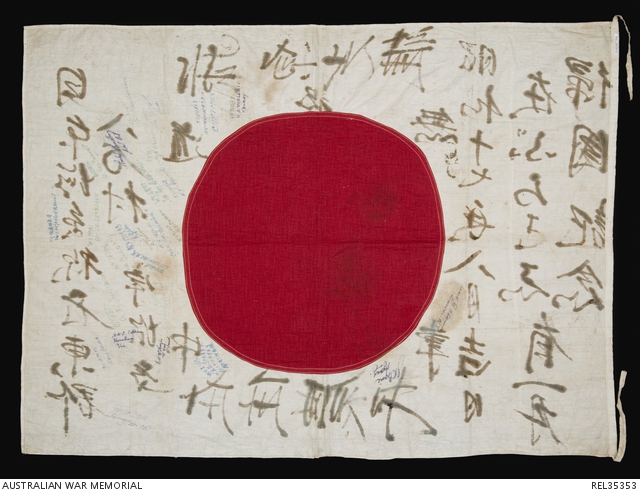| Place | Asia: Borneo, North Borneo |
|---|---|
| Accession Number | REL35353 |
| Collection type | Heraldry |
| Object type | Flag |
| Physical description | Cotton |
| Maker |
Unknown |
| Place made | Japan |
| Date made | 1942-1945 |
| Conflict |
Second World War, 1939-1945 |
Japanese Welcome Home flag carried by Fujiwara Mitsuo : Sergeant C E Lundgren, Z Special Unit


Cotton Japanese flag, dating from 1942, bearing black ink characters. There is a single self fabric tie at each end of the hoist. The flag, presented to Japanese soldier Fujiwara Mitsuo on 'this auspicious day' in August 1942', commemorates his safe return from war service. It also wishes him a safe future journey, implying that he may have returned home to his village while on leave. The flag was subsequently signed by approximately 26 members of Z Special Unit in 1945, some of whose members had captured it. Those signatures that can be identified are as follows (unless otherwise specified all served with Z Special Unit): NX69781Sergeant Gerard Beltrand Alexander; J H Barrie?; WX21667 Private Keith Robert Donald Scarff; QX24484 Captain Neal Booth McKenzie, MC, 2/7 Commando Squadron; NX11724 Sergeant Harold Richmond Fredericks; NX129992 Douglas Bowen; VX105386 Sergeant Mervyn Aubrey Lascelles Collins; WX16967 Corporal Reginald George 'Hock' Taylor; WX16705 Warrant Officer 2 Bertram Charles Long; WX17701 Sergeant Charles Ernest Lundgren; WX16848 Sergeant Eric Ray Spurlinger; NX171983 Corporal Ronald John Biggs; NX15874 Sergeant Colin Reginald Gibbs, Royal Australian Engineers; NX15749 Sergeant Norman Ellis Rusden Gilman; VX56026 Corporal John Douglas Onslow; WX16899 Signalman Royston Harold Campbell; NX114963 Sergeant Francis Vincent Pippen; Jack Brett?; NX58533?; NX42041 Corporal Neville Bruce 'Bluey' Graham; WX17377 Corporal Ross William Bradbury; SX23876 Sergeant Ray Clarence Bennett; NX125429 Warrant Officer 1 Colin William McPherson; NX53660 Corporal Robert McArthur 'Exterminator' Chapman; VX71087 Sergeant Norman Alexander Wallace; and NX88264 Corporal Allen Scott Wheelhouse.
Charles Ernest 'Tiny' Lundgren was born in Fremantle, Western Australian in November 1920. He was studying accountancy when he enlisted in the Citizens Military Force on 17 December 1940, where he was assigned the service number W1693 and posted to 25 Light Horse (Machine Gun) Regiment. He was discharged to enlist in the Second AIF shortly after his 21st birthday, in November 1941. Lundgren trained as a signaller and served within Australia in Western Australia, Victoria and New South Wales. He was promoted to corporal in November 1942, to acting sergeant in August 1944 and to sergeant in January 1945. On 19 November 1943 he transferred to Z Special Unit. From June 1944 Lundgren was involved in the manning of advanced wireless stations in the Admiralty Islands (June to August 1944), on Biak Island (August to October 1944), at Hollandia (October 1944 to February 1945), and on Morotai (February to April 1945). From Morotai he was flown to Labuan Island, then, by Auster aircraft to the bamboo covered airstrip at Belawit in Dutch Borneo, where he worked at the main wireless station coordinating Operation Semut I. Later, together with Lieutenant Colin Thornton. Lundgren moved north on foot from Belawit, through Ba Kelalan, Pa Pala and Long Semadoe into British North Borneo (now Sabah, in Malaysia) to meet Warrant Officer Colin McPherson and Corporal Johnny Onslow. The four Z Special operatives the continued on to Long Pa Sia, Long Miau, Eburu, Bole and Ulu Bole in the Padas area where Japanese soldiers were threatening the native population. It was during this patrol, during a skirmish with retreating Japanese, that Lundgren captured Fujiwara's personal flag after he had been killed. Charlie Lundgren continued to served in Borneo until December 1945. He was discharged on 4 April 1945.
Share this page
Related information
Conflicts
Places
Subjects
People
- Long, Bertram Charles
- Barrie, John Keith
- Alexander, Gerard
- Lundgren, Charles Ernest
- Wheelhouse, Allen Scot
- Bennett, Ray Clarence
- Fredericks, Harold Richmond
- McPherson, Colin William
- Onslow, John Douglas
- Campbell, Royston Harold
- Gibbs, Ronald John
- Chapman, Robert McArthur
- Graham, Neville Bruce
- Gilman, Norman Ellis Rusden
- Pippen, Francis Vincent
- Thornton, Colin Reginald